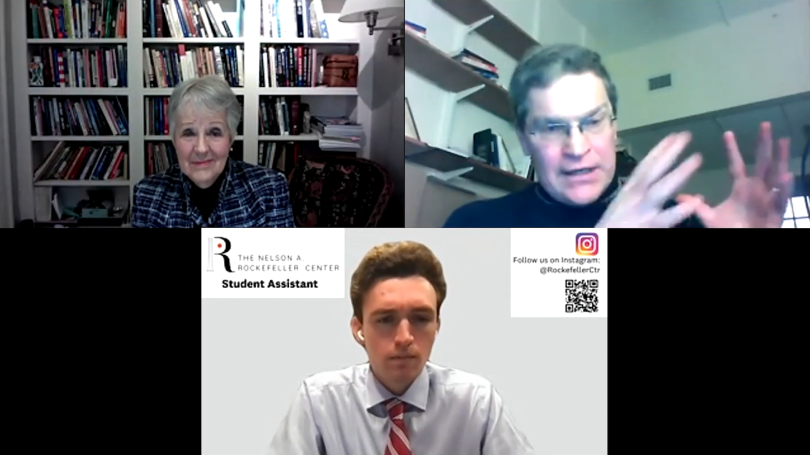
- Public Policy
- Leadership
- Funding
- News & Events
- About the Center
Back to Top Nav
Back to Top Nav
Back to Top Nav
Back to Top Nav
On Thursday, January 21st, 2021, Matthew Dickinson, Professor of Political Science at Middlebury College, and Linda Fowler, Dartmouth Professor of Government and Frank J. Reagan Chair in Policy Studies, Emerita, spoke with students and community members at the Rockefeller Center’s third Rocky Watch event of the term. Rocky Watch is a weekly series of live broadcasts that create a virtual common space for community learning, discussion, and engagement in this time of remote learning.
Thursday’s lecture explored the state of American political institutions at the outset of Joe Biden’s presidency and featured an introduction by Jason Barabas, Director of the Rockefeller Center.
Professors Dickinson and Fowler offered an assessment of the state of American politics going into 2021. Professor Dickinson emphasized that in spite of the difficulties faced by American democracy in recent decades—culminating in the storming of the United States Capitol on January 6th— “we were able to pull off an election.” However, Dickinson noted that “there is a deep dissatisfaction with our institutions” and that the rage that led to the storming of the Capitol is “just the tip of the iceberg.”
Professor Fowler recalled a “different kind of invasion of the Capitol,” namely, when paratroopers locked down the building during the protests of the Vietnam War. To Fowler, the occupation of the Capitol by the National Guard earlier this month was reminiscent of those chaotic times. Like Dickinson, Fowler observed that public trust in government remains near historic lows and satisfaction with democracy has decreased markedly. With that in mind, Fowler wondered if there is something about the constitutional system that is “contributing to the dissatisfaction and potential for violence that we have now.”
Answering this question, Dickinson pointed out that “we have a government of separated institutions sharing power,” which makes it “difficult to change the status quo unless there is overwhelming support for that.” Today however, we live in an era of rapid change and increased political participation, leading us to “expect more of our government.” Dickinson worries that today’s “hyper-partisan democracy” may not be compatible with the republican form of government that the Framers had in mind.
In that vein, Fowler commented on the limits of having Congress divided into two coequal chambers. “Too often,” Fowler says, “the House and the Senate are not able to agree,” preventing legislation from being passed. This trend is compounded by hyper-partisanship and the fact that “the Senate tends to overrepresent rural states” while the House “represents coastal states and big cities,” making the chambers at odds. Due to these limits, “people now expect that it’s the president who is supposed to fix things.” Therefore, the paralysis of Congress has empowered the executive branch.
The Framers, Dickinson added, knew that “the paper barriers of the Constitution would [not] deter tyrants.” To that end, each branch was intended to counter the ambitions of the other branches. However, the Framers neglected one important detail: they “assumed that people’s loyalties to their own institution would supersede any other loyalty.” Unfortunately, “hyper-partisanship has… disrupted that kind of balancing act.” As demonstrated by recent events, loyalty to the president or party leader has called into question the premise that “members of Congress are first members of Congress.” Congress is no longer as potent a check on the presidency as it once was.
Political power has been flowing to the executive branch for nearly a century. Dickinson credited Franklin Roosevelt with vastly expanding the powers of the presidency by being one of the first presidents to set legislative agendas and through using radio to speak directly to the American people. Presidents today can “target their audience” with political rhetoric, generating unprecedented influence and controversy. “Every president,” Dickinson emphasized, has “built on that foundation that Franklin Roosevelt laid.” Dickinson worries how an increasingly emboldened executive branch will compensate for the power vacuum both he and Fowler observe in Congress.
In spite of these ominous trends, Fowler sees bright spots in America’s governing institutions. For example, a bipartisan coalition of Senators overcame President Trump’s veto on the 2021 defense bill. Moreover, reform movements frequently emerge after periods of abuse by the executive branch, and Fowler speculates that the “very real physical fear that [Congress] members experienced” during the storming of the Capitol could initiate a new wave of reform. Like Fowler, Dickinson hopes for reform, but is skeptical it can be achieved while “both parties are struggling with extremists who are often more concerned with catering to interest groups and strong partisan voices” than governing.
Written by Ben Vagle ’22, Rockefeller Center Student Assistant for Public Programs
Rocky Talk Podcast Regarding The Fragile State of American Political Institutions: Apple Podcasts and Spotify.